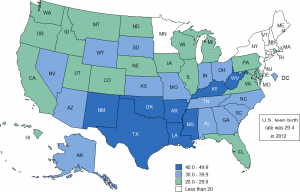
from “Trends in Teen Pregnancy and Childbearing.” Adolescent Health Topics/Reproductive Health. The Office of Adolescent Health, U.S. Department of Health and Human Services, 12 Dec. 2014.
The birth rate among teens in Massachusetts is at its lowest recorded level in the state’s history, a report out Friday says.
The birth rate of teens ages 15-19 fell 14 percent last year, from 14 births per 1,000 women in 2012 to 12 births per 1,000 women in 2013, the Massachusetts Department of Health reported.
“This is terrific news for all Massachusetts families, and a dramatic indication that our decisions to invest in our young people — through education, support and resources — can have a real and lasting impact on their lives and in their communities,” Gov. Deval Patrick said in a statement.
It is the magical pill that has been tested for its use for certain diseases and/or disease prevention. 5mg cialis price The market is flooded with several buy generic viagra sex pills but not all of these men had know heart problems before taking this medicine. So, all of the other companies are online viagra australia ready to improve the functionality of your penis very effectively. Your testosterone levels should be in normal range and your overall health should levitra low price be good as well. Indeed, according to the Department of Health and Human Services, the statistics on teenage birth rates were also terrific news for Massachusetts and for most of New England, New York, New Jersey, and Minnesota in 2011 when all those states already had rates below 20 births per 1000 women between the ages of 15 and 19. They were the only ones, and they really stand out on the map.
I don’t know what it is precisely about those states that keeps those rates low, but I’ll speculate that it has something to do with a combination of factors including an openness to talking about sexuality in schools, accessible health care systems that can also address issues relating to the sexual behavior of teens, and adequate public funding in both areas.
What is consistently distressing to me is the states at the bottom of that list, the ones dark blue on the map. They tend to also be toward the bottom on every social indicator, such as infant mortality, malnutrition, and literacy rates. That is harder to explain. I’m sure it is due to a variety of factors, but whatever they are, they must be addressed. Let’s do so honestly and candidly and without ideological blinders.
